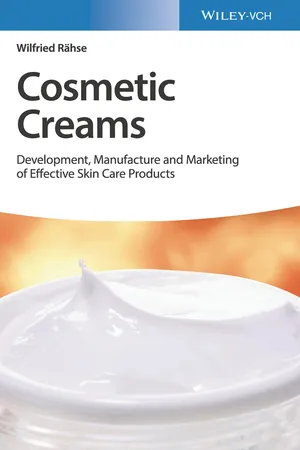
Cosmetic Creams
Development, Manufacture and Marketing of Effective Skin Care Products
- English
- ePUB (mobile friendly)
- Available on iOS & Android
Cosmetic Creams
Development, Manufacture and Marketing of Effective Skin Care Products
About This Book
A guide to cosmetic creams that focuses on formulation, production, and safety concerns Cosmetic Creams: Development, Manufacture and Marketing of Effective Skin Care Products puts the focus on the structure and formulation of a cosmetic cream, the production process, the effect of each ingredient, as well as safety considerations. Comprehensive in scope, the book contains a basic definition of cosmetics and describes the types of skin creams currently on the market, the major ingredients used, and example compositions. The author, Wilfried Rähse?a noted expert on the topic?offers guidelines for estimating manufacturing costs and includes procedures for an effective safety assessment. The book contains information on various aspects of skin penetration and production and covers issues like materials used and hygienic packaging. In addition, Rähse reviews legal regulations with an emphasis on the European market. He discusses GMP and EHEDG directives. This important book: -Offers a comprehensive resource that explores all aspects of cosmetic cream manufacturing and marketing
-Provides valuable guidelines for practitioners in the field
-Covers the underlying technologies of cosmetic creams
-Includes a review of raw material and manufacturing costs, hygiene and safety, and legal regulations
-Written by an author with more than 30 years? experience in the industry Written for cosmetic chemists, chemists in industry, chemical engineers, dermatologists, Cosmetic Creams: Development, Manufacture and Marketing of Effective Skin Care Products, offers a unique industrial perspective of the topic that is comprehensive in scope.
Frequently asked questions
Information
1
General and Legal Aspects of Cosmetics
1.1 Short Look at the History of Cosmetics
1.2 Definition of Cosmetics
Table of contents
- Cover
- Table of Contents
- Preface
- Prior Publications
- 1 General and Legal Aspects of Cosmetics
- 2 Economic Importance of Cosmetics
- 3 Cost Structure of the Cosmetic Products and Their Manufacturers
- 4 Scientific Descriptions of the Skin
- 5 Composition of Creams for Skin Care
- 6 Proven Active Ingredients for Various Categories of Skin Creams
- 7 Active Ingredients for Special Products
- 8 Proposals for the Formulation of Creams
- 9 Perfumes
- 10 Production of Cosmetic Creams
- 11 Regulations and Guidelines for the Execution of Hygienic Productions
- 12 Assessment of the Quality of Cosmetic Creams
- 13 Product Information File (P.I.F.)
- Appendix A: Appendix AFormulationsFormulations
- Appendix B: Appendix BMSDS NiacinamideMSDS Niacinamide
- Index
- End User License Agreement